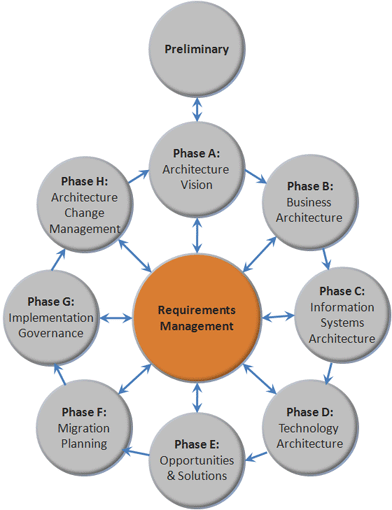The steps in the Requirements Management phase are described in the table below:
|
Requirements Management Steps |
ADM Phase Steps |
Step 1 |
|
Identify/document requirements - use business scenarios, or an analogous technique |
Step 2 |
Baseline requirements:
- Determine priorities arising from current phase of ADM
- Confirm stakeholder buy-in to resultant priorities
- Record requirements priorities and place in requirements repository
|
|
Step 3 |
Monitor baseline requirements |
|
Step 4 |
|
Identify changed requirements:
- Remove or re-assess priorities
- Add requirements and re-assess priorities
- Modify existing requirements
|
Step 5 |
Identify changed requirements and record priorities:
- Identify changed requirements and ensure the requirements are prioritized by the architect(s) responsible for the current phase, and by the relevant stakeholders
- Record new priorities
- Ensure that any conflicts are identified and managed through the phases to a successful conclusion and prioritization
- Generate Requirements Impact Statement (see 36.2.18 Requirements Impact Assessment)for steering the architecture team
Notes
- Changed requirements can come in through any route. To ensure that the requirements are properly assessed and prioritized, this process needs to direct the ADM phases and record the decisions related to the requirements.
- The Requirements Management phase needs to determine stakeholder satisfaction with the decisions. Where there is dissatisfaction, the phase remains accountable to ensure the resolution of the issues and determine next steps.
|
|
Step 6 |
|
- Assess impact of changed requirements on current (active) phase
- Assess impact of changed requirements on previous phases
- Determine whether to implement change, or defer to later ADM cycle; if decision is to implement, assess timescale for change management implementation
- Issue Requirements Impact Statement, Version n+1
|
Step 7 |
|
Implement requirements arising from Phase H
The architecture can be changed through its lifecycle by the Architecture Change Management phase (Phase H). The requirements management process ensures that new or changing requirements that are derived from Phase H are managed accordingly. |
Step 8 |
Update the requirements repository with information relating to the changes requested, including stakeholder views affected |
|
Step 9 |
|
Implement change in the current phase |
Step 10 |
|
Assess and revise gap analysis for past phases
The gap analysis in the ADM Phases B through D identifies the gaps between Baseline and Target Architectures. Certain types of gap can give rise to gap requirements.
The ADM describes two kinds of gap:
- Something that is present in the baseline, but not in the target (i.e., eliminated - by accident or design)
- Something not in the baseline, but present in the target (i.e., new)
A "gap requirement" is anything that has been eliminated by accident, and therefore requires a change to the Target Architecture.
If the gap analysis generates gap requirements, then this step will ensure that they are addressed, documented, and recorded in the requirements repository, and that the Target Architecture is revised accordingly. |

